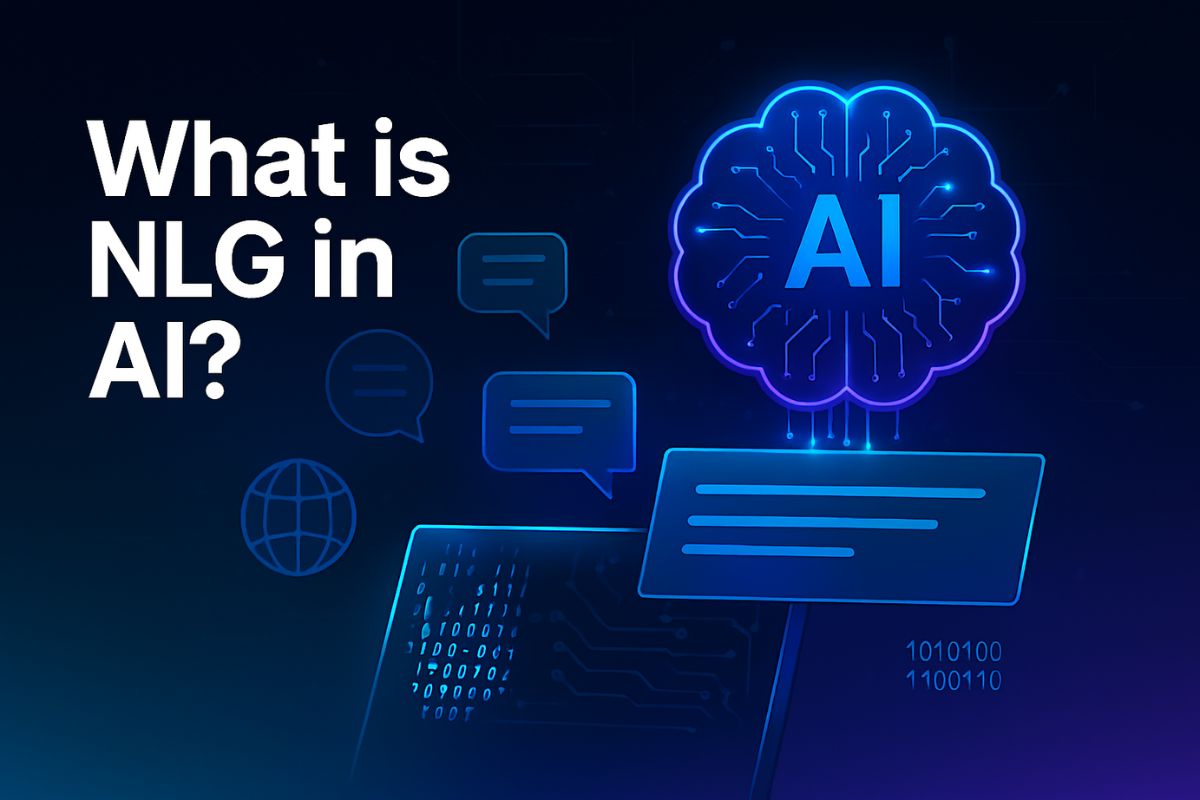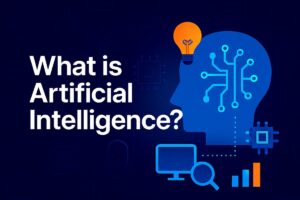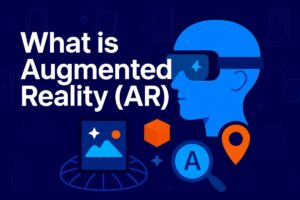Natural Language Generation (NLG) is an AI technology that converts structured data into human-like text or speech. Used in chatbots, automated journalism, and business reports, NLG powers real-time, scalable content creation. This guide explains how NLG works, its types, benefits, real-world examples, challenges like hallucinations, and its future in the AI ecosystem.
Imagine a machine writing an article, generating a product description, or summarizing a sports event—all without human input. That’s the magic of Natural Language Generation (NLG). NLG is a key subfield of artificial intelligence (AI) focused on turning raw data into readable, fluent text or spoken words.
From virtual assistants and financial reports to smart speakers and automated content platforms, NLG is powering the future of AI-driven communication. In this blog, we’ll explore what NLG is, how it works, its types, benefits, real-world use cases, challenges, and what the future holds.
What is Natural Language Generation (NLG)?
Natural Language Generation (NLG) is the AI-based process of transforming structured data into coherent, human-readable text or speech. It’s one of the three major branches of Natural Language Processing (NLP), alongside Natural Language Understanding (NLU) and Natural Language Processing (NLP).
While NLP focuses on interpreting and processing language input, and NLU focuses on understanding the meaning, NLG handles the output side—writing or speaking like a human.
Types of NLG
There are two primary types of NLG systems:
- Extractive NLG: Uses predefined templates or sentence fragments pulled from existing content. It’s fast and efficient but lacks creativity. Example: auto-generated weather reports.
- Abstractive NLG: Uses AI models (like GPT) to generate completely new sentences, summarizing or paraphrasing information. It mimics human creativity and tone but is harder to control and prone to hallucination.
How NLG Works – Process & Stages
The NLG process generally follows these five stages:
- Content Selection
Identifying relevant data points from input (e.g., temperature, date, stock prices). - Document Structuring
Organizing data logically (intro, body, conclusion). - Sentence Planning
Deciding the grammatical structure and flow of each sentence. - Lexicalization
Choosing words and phrases appropriate for the content and tone. - Surface Realization
Finalizing the output into natural, grammatically correct text.
Modern NLG models like GPT-4 combine many of these steps using deep learning, enabling more dynamic and adaptive output.
NLG vs NLP vs NLU
| Concept | Purpose | Input | Output |
|---|---|---|---|
| NLP | Process natural language | Text or speech | Parsed or structured data |
| NLU | Understand language & intent | Natural language input | Meaning, sentiment, intent |
| NLG | Generate human-like language | Structured or unstructured data | Text or speech |
Key Benefits of NLG
1. Automates Content Creation
NLG can write thousands of reports, product descriptions, or summaries in seconds, dramatically reducing human workload.
2. Enhances Business Intelligence
It transforms complex dashboards and metrics into easy-to-read narratives for managers and decision-makers.
3. Enables Personalization at Scale
NLG allows personalized messages or recommendations for millions of users—ideal for marketing, e-commerce, and customer service.
4. Boosts Accessibility
Voice-enabled NLG applications help visually impaired individuals consume content through smart assistants.
5. Reduces Operational Costs
By automating repetitive writing tasks, companies save both time and money.
Real‑World Examples & Use Cases in 2025
1. Automated Journalism
News agencies like the Associated Press and Reuters use NLG to generate sports summaries, election results, and financial updates within seconds.
2. Financial Reporting
Tools like Arria NLG and Yseop generate earnings reports, KPI summaries, and audit narratives for enterprises.
3. E-commerce Descriptions
Retailers use NLG platforms to auto-generate product descriptions, saving thousands of hours in manual work.
4. Healthcare
NLG converts patient data into clinical summaries, enabling faster diagnoses and reporting.
5. Chatbots & Virtual Assistants
Systems like ChatGPT, Alexa, and Siri rely heavily on NLG to provide meaningful responses in natural language.
Challenges & Risks of NLG
1. Hallucinations
NLG systems may “hallucinate” facts—i.e., generate content that sounds correct but is false. This is a major issue in areas like healthcare or finance.
2. Bias in Language Models
AI systems trained on biased data may produce biased or offensive outputs.
3. Evaluation Metrics
NLG outputs are difficult to evaluate. Common metrics like BLEU, ROUGE, and METEOR often fail to capture true readability and quality.
4. Lack of Explainability
Complex language models like GPT-4 lack transparency, making it hard to explain why a particular sentence was generated.
Expert Tips & Common Mistakes in NLG Projects
- Always validate AI-generated text with human review
- Choose the right NLG model based on your use case
- Monitor for hallucinations and ethical issues
- Use temperature and max tokens settings wisely in prompt-based models
- Don’t blindly trust AI-generated summaries in sensitive domains (like medical reports)
- Avoid deploying models without continuous feedback loops and monitoring
Tools & Free Resources for NLG
| Tool/Platform | Description |
|---|---|
| GPT-4 / ChatGPT API | Advanced generative model for NLG tasks |
| Edge Impulse | NLG models for embedded systems |
| Hugging Face | Open-source NLG models and datasets |
| Wordsmith | Popular enterprise NLG tool used by AP |
| IBM Watson NLG | Enterprise-ready NLG for business applications |
Future Scope of NLG – Trends to Watch
1. Multimodal NLG
AI systems are now capable of generating text from not just data—but also images, videos, and audio.
2. Real-Time, On-Device NLG
Edge AI is enabling fast, offline NLG processing in smart devices, especially in wearables and voice assistants.
3. Responsible NLG & Explainability
Governments and researchers are working on frameworks to ensure AI-generated content is ethical, traceable, and explainable.
4. Fine-Tuned Niche Models
Smaller, domain-specific NLG models are being trained for healthcare, law, finance, and more.
5. Integration with Knowledge Graphs
Combining NLG with knowledge bases improves the factual accuracy of generated content.
Conclusion
Natural Language Generation (NLG) is a foundational AI technology that is transforming how humans interact with machines—and how machines create content. From speeding up workflows to enhancing personalization and accessibility, the impact of NLG is massive and growing.
As technology matures and more businesses embrace automation, NLG will continue to be a game-changer in communication, education, marketing, and beyond.
💬 Found this useful? Share it with your team or audience!
FAQs
1. What is the difference between NLG, NLP, and NLU?
NLP processes language, NLU understands it, and NLG generates it.
2. Can NLG replace human writers?
It can automate repetitive tasks, but human creativity and oversight are still essential.
3. What is an example of NLG in real life?
Automated financial reports or chatbots giving real-time, dynamic answers are common NLG examples.
4. How do you evaluate NLG quality?
Common metrics include BLEU, ROUGE, METEOR, and human evaluations for fluency and relevance.
5. What causes hallucination in NLG?
Hallucination occurs when the model generates plausible but incorrect or unverifiable content.
6. Which industries benefit most from NLG?
Media, finance, healthcare, e-commerce, and customer service are the top adopters.
7. What are the top tools for NLG development?
GPT-4, Wordsmith, IBM Watson, Hugging Face Transformers, and OpenAI APIs.



